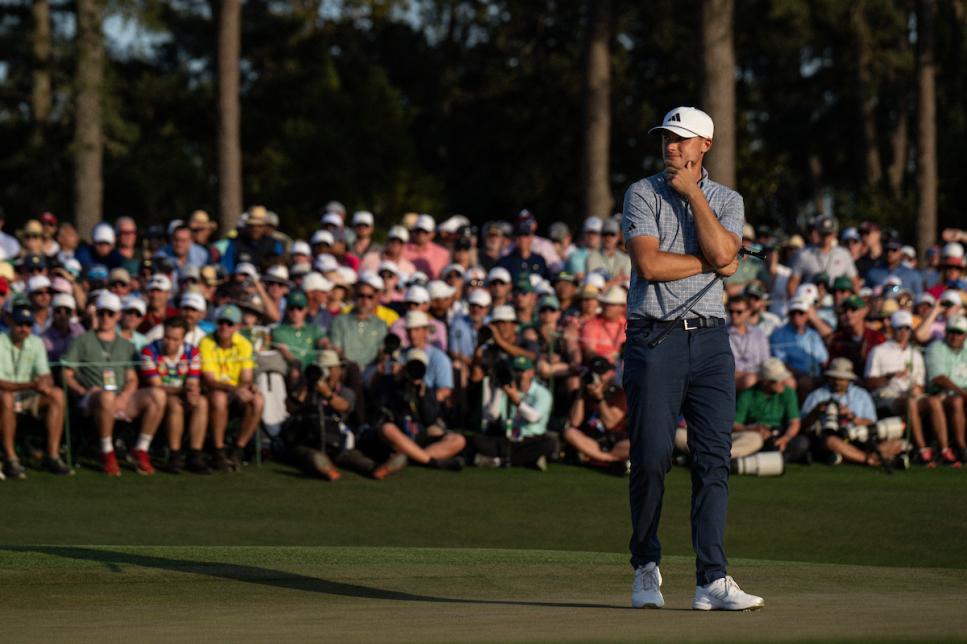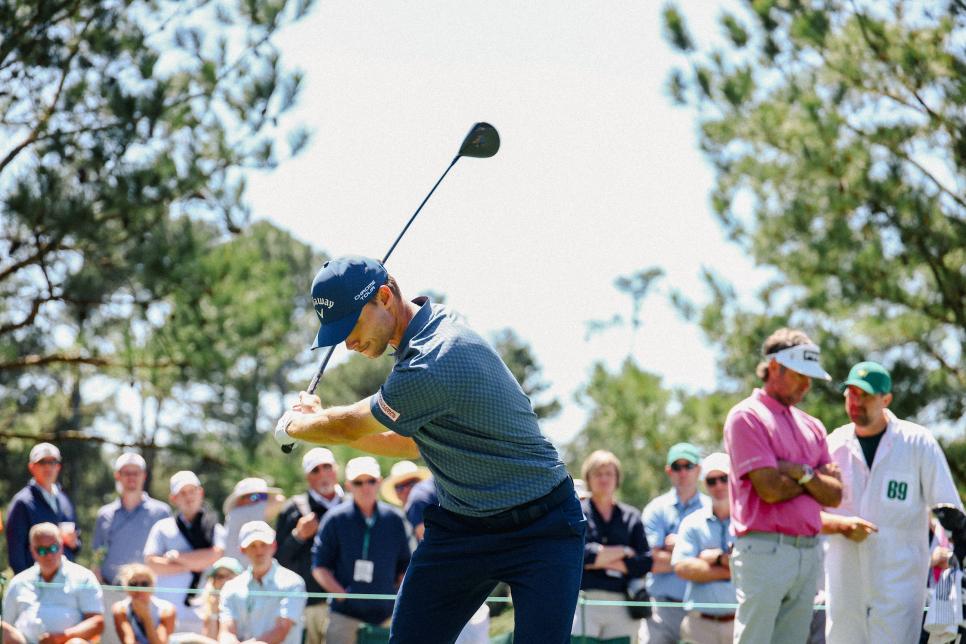[PHOTO: Ben Walton]
Something you’ll often hear in sports – all sports, not just golf – is that it’s impossible for any athlete to be as dominant as the best players were in bygone eras. The talent pool is too deep. Advanced statistics have stripped away the inefficiencies. Better coaching and equipment have closed the gap. Reasons, reasons, on and on.
Sometimes, the reasons even make a lot of sense.
I think back to 2015, when people would explain why no horse would ever win the Triple Crown again. The contenders would skip the second leg (Preakness) if they lost the first leg (Kentucky Derby), the logic when, and therefore return fresher than the horse vying for its third title at the Belmont.
And then, it happens. Horse racing got its first Triple Crown winner since 1978 in American Pharoah, and then three years later Justify accomplished the feat.
Spells of dominance don’t happen often because spells of dominance are hard to produce, but it doesn’t then follow that they’re impossible to repeat again in the future. Things change in sports. Vacuums open, and new players rush in to fill them – and learn to dominate in innovative new ways.
Golf is in the midst of that moment right now.
Scottie Scheffler is the first player since Tiger who is clearly the best player in the game – and then proves it. He was obviously going to win the Players Championship, and he did. Then he was obviously going to win the 2024 Masters, and he did.
“He’s on an historic heater,” said Dr Bhrett McCabe as we watched Scheffler drive his ball into the greenside bunker on Augusta National’s third hole in the final round, then blast his ball to tap-in range to extend his lead to three shots.
“He’s not Tiger, but he’s generational. He’s operating on a completely different level.”
1. Progress is slow, simple and boring
For as flashy as Scottie’s slip-sliding footwork is, that’s really not the reason why it’s good. The reason why he’s good is far more boring than that.
Scheffler has had the same coach for the better part of 20 years – the legendary coach Randy Smith, a genius of the craft. Look back on his swing from his junior golf days and it’s really not that much different. Sure, there are little things, but there would be no mistaking that this is the same golfer.
Scottie Scheffler hitting a wedge (age 17) vs. Scottie Scheffler hitting a wedge (age 27) pic.twitter.com/lkj4Hvaz3W
— LKD (@LukeKerrDineen) April 15, 2024
The lesson here is that there was no breakthrough moment to Scheffler’s career. He just lives on a constant state of making tiny little improvements. He’s never not changing, and he’s never making wholesale changes. He checks his grip religiously. His alignment and weight shift, too. He makes sure his swing doesn’t move too severely in one direction or the other.
“It’s a big part of my practice, and usually what I do at the beginning of my practice each day is focus on my fundamentals,” he told me at the start of the week. “When my swing gets off, it’s usually something that’s very basic about what I’m doing.”
Slow, simple, boring, consistent. Lots of little upgrades. That’s what moving from good to great looks like.
2. Embrace a results mindset
The nature of professional golf is that you’re trying to cash cheques, and win, every single week. All while trying to get a little bit better. Or, at the very least, make sure you’re not getting any worse.
It leads to a lot of pros embracing what I call a “results mindset”. When they’re adopting a change – to their swing, equipment, or anything else – they become acutely aware of the early returns. The results may not be perfect every time, but ask yourself:
• Do you like what you see on those good shots?
• Can you work with the discomfort of making the change?
• Do you feel like you can do, physically, what you’re being asked?
• Are the bad shots better?
If the answer to one or any of those questions is no, then pros will quickly scrap it and look for something new.
“If I don’t see the shots I want to pretty much right away, I’ll discard that until I find something that gives me the results I want to see,” Bryson DeChambeau says. “That’s what gives me confidence. I’m in a place now where I’ve figured some stuff out with my golf game, golf swing. I’m just in a comfortable place where I know I can keep doing the same thing every single week.”
3. Find a new feel for the same thing
Perhaps the most difficult thing for coaches out here is figuring out a new way to say the same thing. The day-to-day of coaching a tour player doesn’t involve too many wild swings.
“Often, as coaches, we’re here to present the information,” says Dana Dahlquist, Golf Digest No.9-ranked coach in the US. “The player then needs to take that information and find a way for it to translate it to the golf course.”

It’s something the rest of us can learn from. The thing you’re working on may not (and probably shouldn’t) change much, but the feeling you’re using to get there probably will.
“Sometimes you search. You’re just trying to find a feel,” Collin Morikawa explains. “Once you find a feel, you can repeat and just put it on repeat all throughout the week.”
4. Embrace the new school waggle
You know one thing I notice all the time these days? That golfers’ waggles look different now.
I’d say a vast majority of players, before their shots, rehearse one move that they’re trying to improve in their swing. Rory McIlroy’s backswing rehearsal is an example, or Max Homa’s upper body tilt towards the ball. So is Ludvig Aberg’s pre-shot setup spacing routine.
The goal, explains Aberg’s coach Hans Larsson, is to make the technical feel natural.
“It solves a technical issue in his golf swing, but he has no idea. When he’s over the ball, he wouldn’t even notice he’s doing it,” he says.
5. Oversimplified head tilts
I thought Michael Breed killed it with his Masters On The Range commentary this week. One thing I found particularly interesting was his analysis of “head tilts”.
Oversimplified, tilting and turning your head in one direction or the other changes the direction your eyes are pointing. That’s important, because your “club path will generally follow where your eyes are pointing”, Breed says.
Breed says a “draw eyeline” is when your eyes are tilted and pointing to the right of your target. A “fade eyeline” is when your eyes are looking to the left of your target. Scheffler uses a draw eyeline to match-up his fade swing, Breed says. McIlroy is an example of a prototypical right-to-left draw swinger.
.@MichaelBreed is killing it with his Masters On The Range coverage.
Cool segment just now on the differences and similarities in Rory and Scottie's head movement.
"Rory creates a draw eyeline. Typically, the club would follow the eyeline out to the right." pic.twitter.com/1uMlbmanLP
— LKD (@LukeKerrDineen) April 14, 2024
6. Look for the patterns
McIlroy didn’t have his best Masters, but I thought we could learn a lot from this quote of his anyway.
One of the keys to getting better? Looking honestly and earnestly at your game. Your goal is to spot the trends, both good and bad. Zoom out on your game and ask yourself: what’s happening?
“Patterns emerge the more that you play,” he says. “I feel like I’ve got a big enough data set of rounds to sort of know how to manage what I’m doing.”
7. Good bogeys vs ‘brain-dead bogeys’
This week, I learned that pros think there are two kinds of bogeys in this world: good bogeys and “brain-dead bogeys”, as Brian Harman put it.
Good bogeys are when you find yourself in some kind of trouble, and turn it into a bogey instead of a double or worse. Hit your ball into the trees, punch out sideways, hit your ball on (or near) the green and two-putt? That’s a good bogey.
Brain-dead bogeys are when you don’t find yourself in trouble and make bogey anyway. A drive down the middle, an iron shot near the green, a substandard chip and three putts? That’s a brain-dead bogey.
Good bogeys are fine. They happen. Brain-dead bogeys (or brain-dead double-bogeys for the rest of us), those are the round-killers.
8. Aggressive doesn’t mean dumb
I was standing with famed caddie Fanny Sunesson, who caddied for Nick Faldo for all three of his green jackets, on Augusta National’s par-3 fourth hole as Max Homa rolled through. The pin was tucked on the back right of the green, and we watched Homa drop a 170-metre iron on a dime, 10 feet away.
“He probably didn’t mean to take that line,” I said.
Fanny looked at me with surprise.
“Yes he did,” she said.
I was confused. If Homa missed short, right or long, he’d be short-sided. Why would he risk that, instead of just aiming for the middle of the green?
The reason why aiming for the pin on the right of the fourth hole was the smart play, Sunesson explained, is because it’s the only flat spot on a big, severely sloped green. The rest of the green may as well not be there.
“The slope is so severe, if you hit the slope the ball doesn’t stay there, it kicks down to the left,” she said. “You don’t want to miss right, but you really don’t want to hit that slope, because it’s a far more difficult shot from over there.”
It was a fascinating insight into Augusta National and also underlined a level of detail that often goes overlooked by the rest of us.
9. Don’t let nerves change your process
I was following Aberg during his final round when I bumped into his coach Larsson. Amazed at how calm this 24-year-old playing in his first major looked as he was contesting for the Masters lead, I asked a simple question:
“Is he even nervous?”
“Of course. Everybody is.” Larsson said.

“But the biggest shift in sports psychology from when I was growing up is accepting that nerves will happen no matter what you do. People used to tell you: when you’re nervous, lie down, take deep breaths, try to stay calm, go to your happy place. But emotions will happen, you can’t control that.”
He continued: “It’s OK that you feel differently, but you must keep acting the same. Doing the same processes that you’ve practised. Give your brain something to focus on, otherwise it will go into instinctual survival mode. It will find something to focus by assessing potential threats to how you feel.”
Aberg didn’t win this time, but he’s doing everything right, and it keeps getting more impressive. Majors are in this guys future – and soon.
10. Golf-swing slumps don’t last forever 
Finally, 23-year-old Nicolai Hojgaard had his best finish in a major – T-16 in his first Masters, spending much of the first few rounds fluttering around the lead. It was a far cry from when I was chatting with him a month earlier, and asked him about his golf swing.
“My swing feels a bit s–t, to be honest,” he said.
A bit similar to Morikawa, playing poorly doesn’t last forever. Keep working on it, and pretty soon, you’ll find a feel that will make you feel like the good golf will never end.

